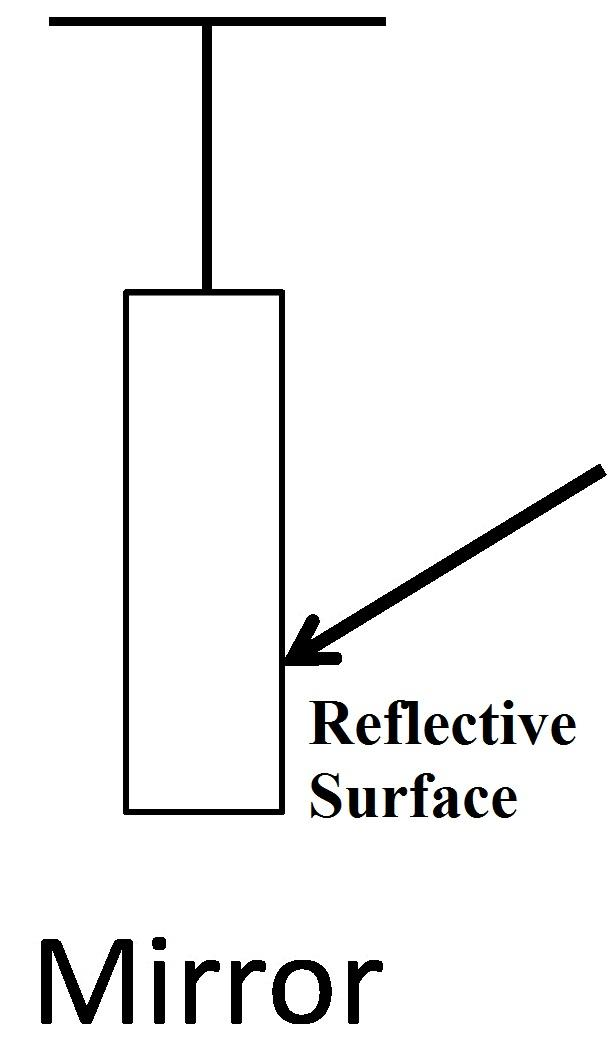
A small mirror of mass $m$ is suspended by a light thread of length $l$. A short pulse of laser falls on the mirror with energy $E$. Then, which of the following statements is correct?

A) If the pulse falls normally on the mirror, it deflects by $\theta = \dfrac{{2E}}{{\left( {mc\sqrt {2gl} } \right)}}$.
B) If the pulse falls normally on the mirror, it deflects by $\theta = \dfrac{{2E}}{{\left( {mc\sqrt {2g} } \right)}}$.
C) Impulse in thread depends on angle at which the pulse falls on the mirror.
D) None of the above
Answer
220.8k+ views
Hint: In order to get the solution of the given question, we need to find the change in momentum of the laser beam. After that, we need to relate it with conservation of momentum and conservation of energy. After comparing, we will get an equation and solving the equation will give us the required solution of the given question.
Complete step by step solution:
The energy of the laser that falls on the mirror is given as $E$.
If we assume the laser beam to be perfectly reflected, then the change in momentum of laser beam is known as $\dfrac{{2E}}{c}.$
Now, if we apply conservation of momentum, we can write it as,
$mv = \dfrac{{2E}}{c}$
$ \Rightarrow v = \dfrac{{2E}}{{mc}}$
As, we know that from conservation of energy, Kinetic energy = Potential energy
Therefore, we can write, $\dfrac{1}{2}m{v^2} = mg(1 - \cos \theta )$………… (i)
Also, from trigonometry, we know that,$1 - \cos \theta = 2{\sin ^2}\dfrac{\theta }{2}$
Now, since the angle is very small, we can write the above relation as, $1 - \cos \theta = 2{\left( {\dfrac{\theta }{2}} \right)^2}$=$\dfrac{{{\theta ^2}}}{2}$
Now, using the above relation in equation (i), we can write it as,
$\dfrac{1}{2}m{\left( {\dfrac{{2E}}{{mc}}} \right)^2} = mgl\dfrac{{{\theta ^2}}}{2}$
$ \Rightarrow {\theta ^2} = \dfrac{{2 \times 2{E^2}}}{{c{m^2}gl}}$
$\therefore \theta = \dfrac{{2E}}{{mc\sqrt {gl} }}$
As we can notice, the required value of the angle is not given in the options of the given question.
Hence, option (D), i.e. none of the above is the correct choice of the given question.
Note: We define a laser beam as a ray of light with high intensity that is generated through the emission of photons (also known as light particles). Photons do not have mass but they are capable of redirecting particles with which they collide and transfer their momentum to them.
Complete step by step solution:
The energy of the laser that falls on the mirror is given as $E$.
If we assume the laser beam to be perfectly reflected, then the change in momentum of laser beam is known as $\dfrac{{2E}}{c}.$
Now, if we apply conservation of momentum, we can write it as,
$mv = \dfrac{{2E}}{c}$
$ \Rightarrow v = \dfrac{{2E}}{{mc}}$
As, we know that from conservation of energy, Kinetic energy = Potential energy
Therefore, we can write, $\dfrac{1}{2}m{v^2} = mg(1 - \cos \theta )$………… (i)
Also, from trigonometry, we know that,$1 - \cos \theta = 2{\sin ^2}\dfrac{\theta }{2}$
Now, since the angle is very small, we can write the above relation as, $1 - \cos \theta = 2{\left( {\dfrac{\theta }{2}} \right)^2}$=$\dfrac{{{\theta ^2}}}{2}$
Now, using the above relation in equation (i), we can write it as,
$\dfrac{1}{2}m{\left( {\dfrac{{2E}}{{mc}}} \right)^2} = mgl\dfrac{{{\theta ^2}}}{2}$
$ \Rightarrow {\theta ^2} = \dfrac{{2 \times 2{E^2}}}{{c{m^2}gl}}$
$\therefore \theta = \dfrac{{2E}}{{mc\sqrt {gl} }}$
As we can notice, the required value of the angle is not given in the options of the given question.
Hence, option (D), i.e. none of the above is the correct choice of the given question.
Note: We define a laser beam as a ray of light with high intensity that is generated through the emission of photons (also known as light particles). Photons do not have mass but they are capable of redirecting particles with which they collide and transfer their momentum to them.
Recently Updated Pages
Two discs which are rotating about their respective class 11 physics JEE_Main

A ladder rests against a frictionless vertical wall class 11 physics JEE_Main

Two simple pendulums of lengths 1 m and 16 m respectively class 11 physics JEE_Main

The slopes of isothermal and adiabatic curves are related class 11 physics JEE_Main

A trolly falling freely on an inclined plane as shown class 11 physics JEE_Main

The masses M1 and M2M2 M1 are released from rest Using class 11 physics JEE_Main

Trending doubts
JEE Main 2026: Application Form Open, Exam Dates, Syllabus, Eligibility & Question Papers

Understanding Uniform Acceleration in Physics

Derivation of Equation of Trajectory Explained for Students

Hybridisation in Chemistry – Concept, Types & Applications

Understanding the Angle of Deviation in a Prism

How to Convert a Galvanometer into an Ammeter or Voltmeter

Other Pages
Thermodynamics Class 11 Physics Chapter 11 CBSE Notes - 2025-26

JEE Advanced Marks vs Ranks 2025: Understanding Category-wise Qualifying Marks and Previous Year Cut-offs

Units And Measurements Class 11 Physics Chapter 1 CBSE Notes - 2025-26

NCERT Solutions For Class 11 Physics Chapter 8 Mechanical Properties Of Solids

Motion in a Straight Line Class 11 Physics Chapter 2 CBSE Notes - 2025-26

Laws of Motion Class 11 Physics Chapter 4 CBSE Notes - 2025-26




